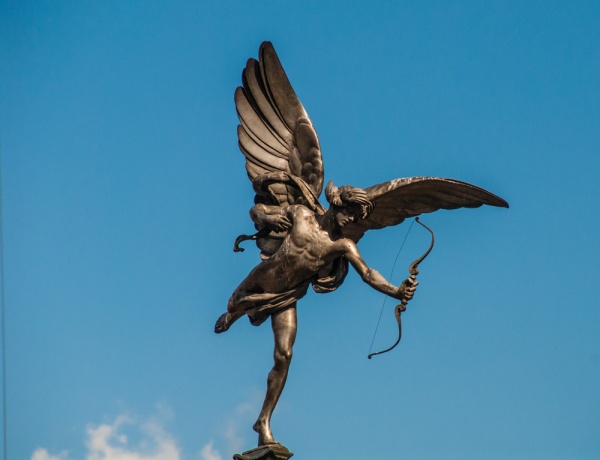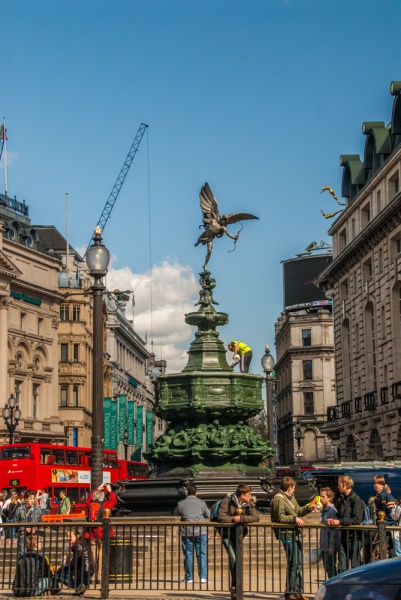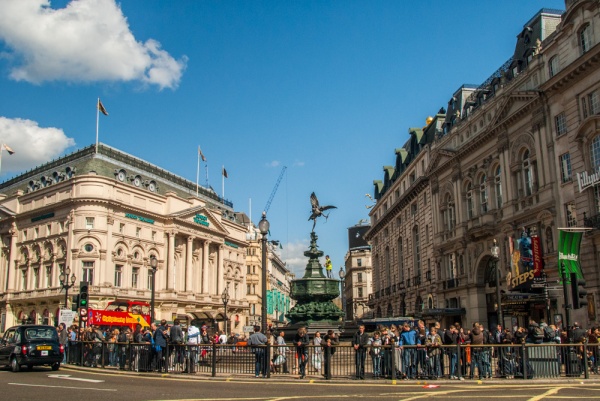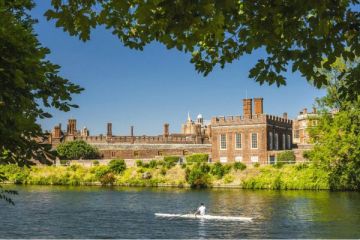
It has been said that if you stand in Piccadilly Circus long enough, everyone in the world will pass by. The large road junction is a popular gathering place for tourists and locals alike and was rather romantically considered the heart of the British Empire.
The 'Circus' has nothing to do with performing animals. The name comes from the Latin for a circle, and refers to the roughly round shape of the traffic junction where Piccadilly meets Regent Street.
The Circus was built in 1819 and is perhaps best known today for the large neon signs and video display mounted on a building on the northern side of the junction. Directly under the junction lies the Piccadilly Circus underground station, and standing around the edges of the Circus are several popular theatres, including the Criterion and the London Pavilion.
The central area of the Circus is a traffic island, where pedestrians wait to cross one of the many crosswalks, while hordes of black cabs and double-decker buses whizz past.

A Case of Mistaken Identity
On the south-eastern side of the traffic island stands an ornate fountain, erected in 1892 in memory of Anthony Ashley Cooper, 7th Earl of Shaftesbury, a politician, philanthropist and social reformer.
Lord Shaftesbury was known for his efforts to reform child labour practices, improve the care of 'lunatics', stop the use of small boys as chimney cleaners, reform the education system, and stop the opium trade. He died in 1885 and though he had been offered a state burial in Westminster Abbey he declined, expressing the wish to be buried in St Giles church on his family estate in Wimborne St Giles, Dorset.
Shortly after his death, a memorial was mooted, and such was the Earl's popularity that sculptor Alfred Gilbert was commissioned to create a suitable memorial within a year of the Earl's death. The commission might have been quick, but Gilbert certainly wasn't; he took fully five years considering how best to commemorate the Earl's life and good works.
His final design was an ornately decorated bronze fountain on a nautical theme, topped by a statue reflecting the Earl's philanthropic life. Thus was born the Shaftesbury Memorial Fountain, originally meant as a public drinking fountain. The bronze base was supposed to support a dome of water, with the mythical figure of a god appearing to float on the surface of the flowing water.
That godlike figure is now London's most famous work of sculpture, popularly known as Eros, the Greek God of love.

Unfortunately, the statue does not depict Eros at all, but in fact depicts the God's twin brother Anteros, the god of requited love, who had the delightful habit of punishing unrequited love and revenging himself on those who reject a lover's advances. The statue was designed by Sir Alfred Gilbert as 'The God of Selfless Love', to commemorate the philanthropic good deeds for which the Earl of Shaftesbury was known.
Gilbert explained his choice of Anteros, saying the god represented 'reflective and mature love, as opposed to Eros or Cupid, the frivolous tyrant.' The model was Gilbert's own studio assistant, a 16-year-old Anglo-Italian youth named Angelo Colarossi. Angelo and his father also served as models for the famous 1892 painting by Frederick, Lord Leighton entitled 'And the Sea Gave Up the Dead Which Were in It'.
The statue was cast by George Broad & Son at the Hammersmith Foundry. It was the first cast aluminium statue in the world, though curiously the fountain itself is bronze. The fountain and statue together stand 1097 cm x 518 cm (432 in x 204 in).
Gilbert's design for the water fountain was flawed from the start. The base was too narrow, so that instead of water flowing smoothly, it splashed everywhere, creating a mass of mud beside the fountain. Gilbert also designed cups chained to the base so that people could more easily drink, but the cups were stolen almost immediately.
The memorial was publicly unveiled on 29 June 1893 by the Duke of Westminster. Given the prudery often associated with late Victorian England, it should come as no surprise that there were immediate public complaints about the nude statue. It was considered too overtly sensual and unsuitable as a memorial to the notably respectable Earl of Shaftesbury.
Its location in the theatre district, considered a haven for inappropriate behaviour, was also thought unsuitable. Some ruffled feathers were smoothed by officially renaming the statue as 'The Angel of Christian Charity', a very Christian approximation of the role Anteros was thought to play in the Greek pantheon of gods.
The statue's official name never caught the public imagination, and Anteros became popularly - and incorrectly - known as Eros.
If the statue's name was the subject of public confusion, so too was the statue itself. Anteros is shown as a winged figure, standing (indeed, almost over-balanced) on the ball of one foot, a bow in his left hand, his right arm drawn back as if to launch an unseen arrow, But where is he aiming?
A popular myth is that the arrow is being aimed up Shaftesbury Avenue, a doff of the cap to the great philanthropist Earl. A different take on the story is that the missing arrow is a rebus, or pun on the name 'Shaftesbury', as in, the archer must have 'buried' the 'shaft' somewhere.
Another myth says that the arrow points directly to the Earl's family home in Wimborne St Giles. Unfortunately, neither story is true. The statue was originally oriented quite differently, and when erected the arrow pointed down Lower Regent Street towards the Palace of Westminster (the Houses of Parliament).
From the start the Eros/Anteros statue was the target of vandals, and the County Council had to appoint a park keeper to protect it.
The artistic criticism aimed at Albert Gilbert's creation was the least of his worries. He was paid £3000 for his work, but it cost him £7000. Most of that expense went towards the richly decorated base of the fountain. He was heavily in debt and was eventually forced to flee abroad and spent 25 years living in Belgium. Gilbert never felt that his work did enough to commemorate Lord Shaftesbury and went so far as to suggest that the whole fountain be melted down and sold, with the money used to build homeless shelters.
In 1922 the statue was moved from its original location in the centre of Piccadilly Circus to allow construction of the tube station. The fountain base was stored in Clapham, while the statue stood in Embankment Gardens until the station was finished. It was re-erected in 1931.
In 1939 the statue was removed for preservation during the course of WWII, and was stored safely in Egham, Surrey, for the duration of the war, while the base was simply boarded up. It was erected in its present location in 1947, with the arrow pointing in a different direction. The statue has had to be repaired several times, and had to have a new bowstring fitted after the original was damaged by a tourist.
The figure of Eros, or Anteros, was adopted by the Evening Standard newspaper. Casts of the sculpture were used to create replicas in Liverpool, Blackpool, and, oddly, in the Adelaide Art Gallery in Australia.
Getting there is ridiculously easy; just take the underground to Piccadilly Circus station and take any exit. You will have to use a pedestrian crossing to reach the fountain.
About Eros Statue, Piccadilly Circus
Address: Piccadilly Circus,
London,
Greater London,
England, W1J 9HS
Attraction Type: Landmark
Location: On a traffic island in the middle of Piccadilly Circus, reached by pedestrian crosswalks.
Location
map
OS: TQ295806
Photo Credit: David Ross and Britain Express
Nearest station: ![]() Picadilly Circus - 0 miles (straight line) - Zone: 1
Picadilly Circus - 0 miles (straight line) - Zone: 1
HERITAGE
 We've 'tagged' this attraction information to help you find related historic attractions and learn more about major time periods mentioned.
We've 'tagged' this attraction information to help you find related historic attractions and learn more about major time periods mentioned.
Find other attractions tagged with:
NEARBY HISTORIC ATTRACTIONS
Heritage Rated from 1- 5 (low to exceptional) on historic interest
Royal Academy of the Arts - 0.2 miles (Museum) ![]()
Burlington Arcade - 0.2 miles (Landmark) ![]()
Spencer House - 0.3 miles (Historic Building) ![]()
Duke of York Column - 0.3 miles (Landmark) ![]()
National Gallery - 0.3 miles (Museum) ![]()
National Portrait Gallery - 0.3 miles (Museum) ![]()
Texas Legation - 0.3 miles (Landmark) ![]()
Admiralty Arch - 0.4 miles (Historic Building) ![]()
Nearest Holiday Cottages to Eros Statue, Piccadilly Circus:
Leaves Green, Greater London
Sleeps: 6
Stay from: £857 - 3127
More self catering near Eros Statue, Piccadilly Circus



